|
Here are some close-up photos of a fragmented clay bulla with an impression from the seal of someone who actually worked for King Hezekiah in ancient Judah! The Biblical Archaeology Society published the first complete specimen in Biblical Archaeology Review magazine (BAR), July/August 2002 v28#4, as a sidebar to an article by Robert Deutsch about the seals of King Hezekiah:
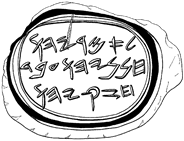
|
לאמריהו
חנניהו עבד
חזקיהו
|
We know that the inscription reads "LAMR[YEU] HNNYE[U OBD] HZ[QYEU]", but the bracketed letters are missing from the fragment shown in the photos below. Keen observers will note minor discrepancies between the drawing published in BAR & the photos of this fragment, especially the relative position of the 2 Het letters beside the Nun & Zayin. This can be explained by either a lack of accuracy in the drawing or 2 similar seals made for the same person.
The magnification estimates of these photos are based on a 17" CRT with a 16" viewable diagonal set to 1024x768 resolution. These first 3 photos are magnified about 7 times (~7x).
The first picture shows the seal with overhead lighting (i.e., a small angle of incidence) that floods the faint stamp; the second picture utilizes shadows created by holding the light source on one side of the bulla so that its rays reveal the small letters (i.e., a large angle of incidence); the third picture shows the bottom where traces remain of the papyrus document fibers & a 2-millimeter thick cord that tied the document.
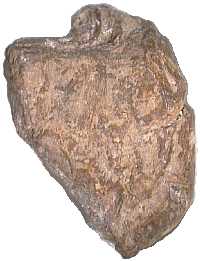
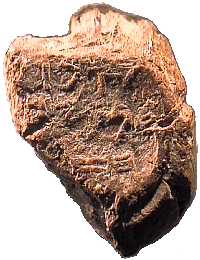
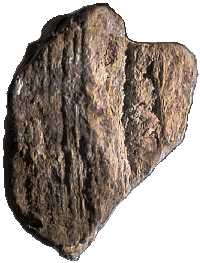
|
This next photo (~3x) allows you to determine the actual size of the overall bulla based on the centimeter scale it's resting upon. You can see that the letter strokes are only about 1 to 2 millimeters long!
|
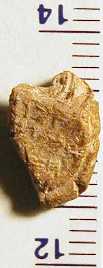
|
|
These next 2 pictures (~7x) show the left side cross-section of the bulla, which is only about 1.0 to 1.5mm thick above where the cord would have been, & about 3mm thick on the outer right side of the bulla where the clay squished over the edge of the cord. The first photo focuses on the cord depression in the middle of the bulla; the second photo focuses on the edge closest to the camera lens (corresponding to the left side of the photos above). These pictures also allow you to visualize how the convex seal put a concave impression in the clay:
|


|
|
This photo (~50x) focuses on a cave-like formation on the fractured side at the bottom of the bulla with a light-colored stalagmite/stalactite growth:
|
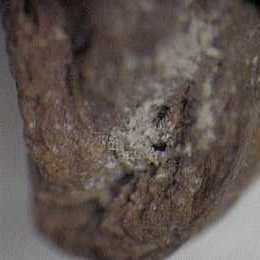
|
|
This is a microscopic close-up (~150x) of a structured crystal embedded in the prominent crack on the side of the bulla positioned in the bottom-right corner of the top side (near the "HZ" of "Hezekiah"):
|
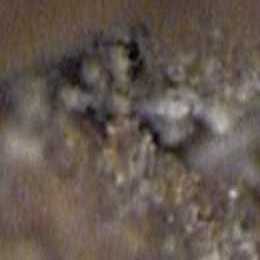
|
These 2 photos (~50x) show the crack on the right side of the bulla (near the "HN" of "Hananiah"). The first one focuses on crystal growth inside the crack; the second one focuses on a glossy, shellac-like patina covering the ridge made by the seal border (note--the overall inscription area is severely abraded, probably due to brush cleaning; only the outer edge of the non-fragmented right side is shiny):
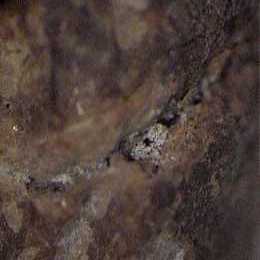
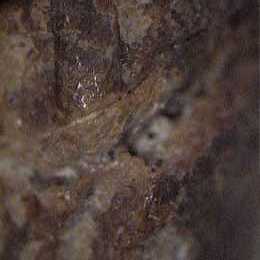
This photo (~100x) shows another view of the shiny patina protruding above the small knob on the bottom of the bulla:
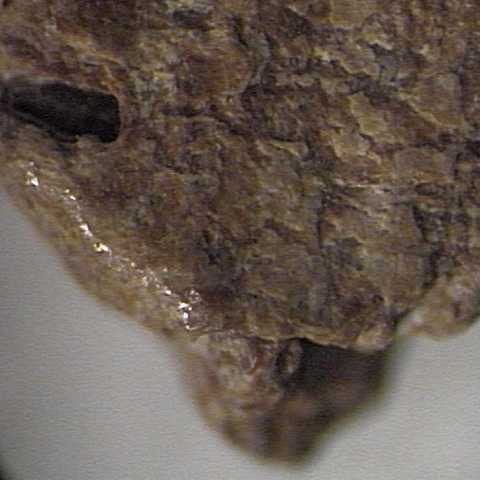
This photo (~50x) shows some barnacle-like grit-crystals in the depression made by the cord on the bottom side of the bulla immediately below the "MR" of "Amariah":
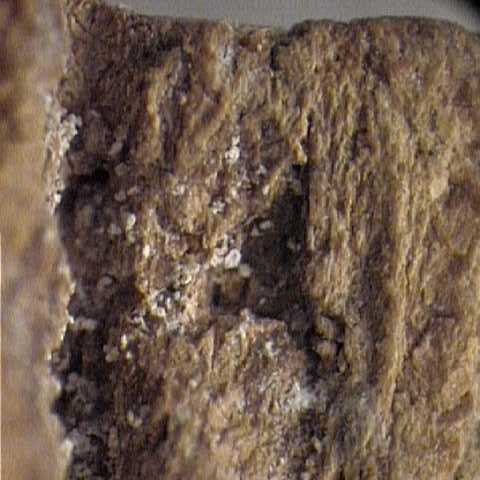
This photo (~50x) shows a close-up of the papyrus lines on the bottom of the bulla (note--the large white grit on the top edge fell out during the photography session & is now missing):
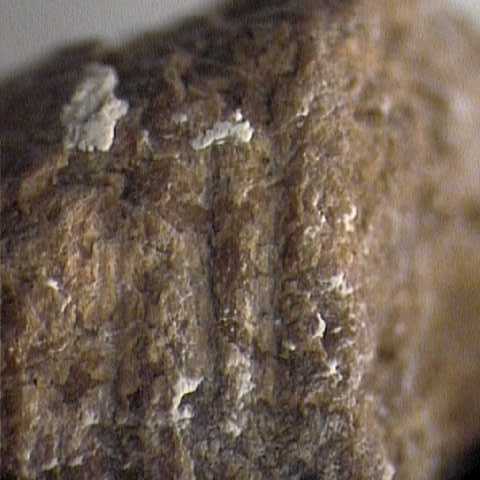
These 2 photos (~50x) show the bottom of the bulla corresponding to the side below the Lamed ("L"). The first one focuses on a large white grit on the surface; the second one focuses on smaller grit-crystals on the side-fracture:
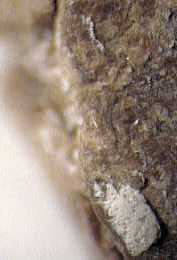
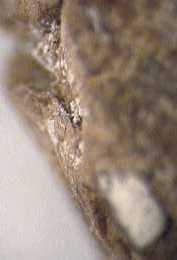
The next 4 photos (~75x) show the letters "LA", "MR", "HN", & "HZ" (note--the "HN" appears discolored due to a digital-processing combination of 2 overlapping photos taken with alternate shadowing):
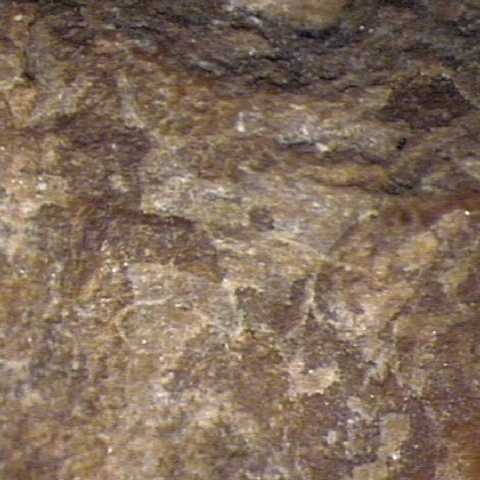
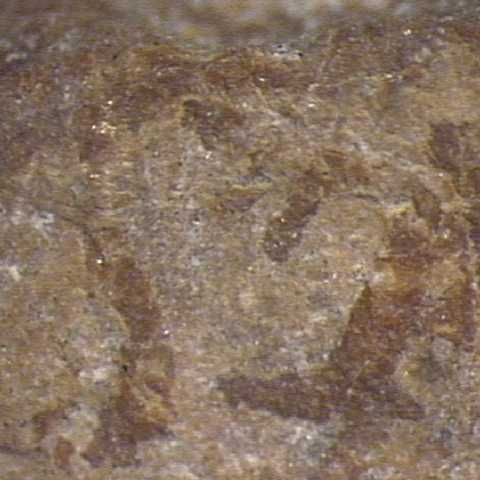
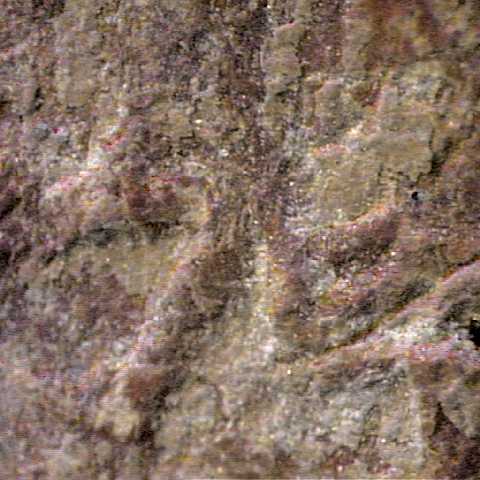
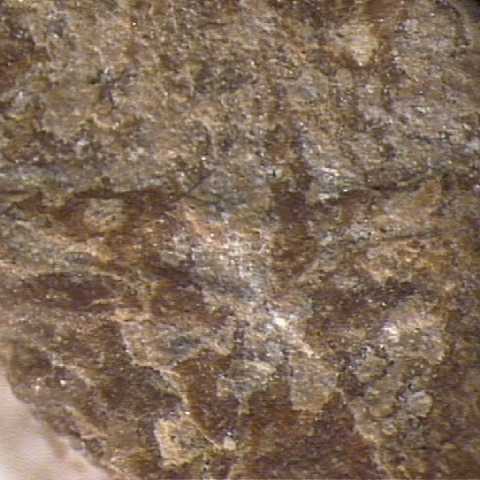

This bulla was transferred from the Gil Chaya collection
(Geneva, Switzerland) to a private collection in Redondo Beach
in 2004 from a group of fragments not identifiable
until recent publications of better specimens.

Who was Amariah (son of) Hananiah?
2Chronicles 31:
12_Then they faithfully brought in the offerings, the tithes, and the dedicated things; Cononiah the Levite had charge of them, and Shimei his brother was the next.
13_Jehiel, Azaziah, Nahath, Asahel, Jerimoth, Jozabad, Eliel, Ismachiah, Mahath, and Benaiah were overseers under the hand of Cononiah and Shimei his brother, at the commandment of Hezekiah the king and Azariah the ruler of the house of God.
14_Kore the son of Imnah the Levite, the keeper of the East Gate, was over the freewill offerings to God, to distribute the offerings of the LORD and the most holy things.
15_And under him were Eden, Miniamin, Jeshua, Shemaiah, Amariah, and Shecaniah, his faithful assistants in the cities of the priests, to distribute allotments to their brethren by divisions, to the great as well as the small.
In the BAR article where the first/best specimen was published, Robert Deutsch quoted verse 15 & speculated:
"Although Amaryahu is not an uncommon name, it is very probable that this Amaryahu is the man mentioned in the Bible. The bulla specifically identifies Amaryahu as a 'servant of Hezekiah', and the Biblical Amaryahu is clearly a high officer in Hezekiah's court. It is highly unlikely that more than one person with this name would hold senior positions in the royal service at the same time."
However, this speculation can be challenged since it's questionable whether the Amariah of verse 15 would carry a seal naming him a servant of Hezekiah rather than one of the following:
- servant of Kore (the Levite of verse 14; see also Numbers 3:6)
- servant of Azariah (ruler of the house of God in verse 13)
- servant of the Temple (i.e., House of God)
- servant of God (Numbers 3:11-13)
Here are all the other Amariahs ("YEU Said") named in the Bible:
- son of Meraioth, father of Ahitub (1Chronicles 6:7 & 6:52)
- son of Azariah, father of Ahitub (1Chronicles 6:11 & Ezra 7:3)
- second son of Hebron (1Chronicles 23:19 & 24:23)
- high priest during the reign of Jehoshaphat (2Chronicles 19:11)
- son of Hezekiah, father of Gedaliah (Zephaniah 1:1)
- son of Bani (Ezra 10:42)
- priest (descendant of Levi) in Nehemiah 10:3 & 12:13 who co-sealed the covenant of chapter 9
- son of Shephatiah, father of Zechariah (Nehemiah 11:4; descendant of Judah)
Except for the ancestor of the prophet Zephaniah, those pre-date or post-date King Hezekiah. The person who published the book of Zephaniah probably traced his genealogy back to somebody famous such as King Hezekiah to convey credibility.
"The word of the LORD which came to Zephaniah the son of Cushi, the son of Gedaliah, the son of Amariah, the son of Hezekiah, in the days of Josiah the son of Amon, king of Judah."--Zephaniah 1:1
Here are all the Hananiahs ("YEU Has Been Gracious") named in the Bible:
- son of Zerubbabel, father of Pelatiah & Jeshaiah (1Chronicles 3:19 & 3:21)
- son of Shashak (1Chronicles 8:24)
- son of the prophet Heman during the reign of King David (1Chronicles 25:4 & 25:23)
- captain under King Uzziah (2Chronicles 26:11)
- son of Azur the prophet during the reign of King Zedekiah (Jeremiah 28:1-17)
- father of Zedekiah--a prince (Jeremiah 36:12)
- father of Shelemiah (Jeremiah 37:13)
- companion of Daniel, descendant of Judah renamed Shadrach (Daniel 1:6, 7, 11, 19; 2:17)
- son of Bebai (Ezra 10:28)
- son of a perfumer (Nehemiah 3:8)
- son of Shelemiah (Nehemiah 3:30)
- leader of the palace (Nehemiah 7:2; probably the same as 10:23)
- priest (descendant of Levi) in Nehemiah 12:12 (probably the trumpet player in 12:41)
Except for the captain under King Uzziah, they all pre-date or post-date the lifetime of King Hezekiah. Only 32 years separated the reigns of Uzziah & Hezekiah, so the father of Amariah named on this seal may have been this famous Capt. Hananiah. That would help explain how this Amariah came to serve under King Hezekiah! And it's also possible to speculate that King Hezekiah named one of his sons (the prophet Zephaniah's ancestor) to honor the servant named on this seal!
|
















